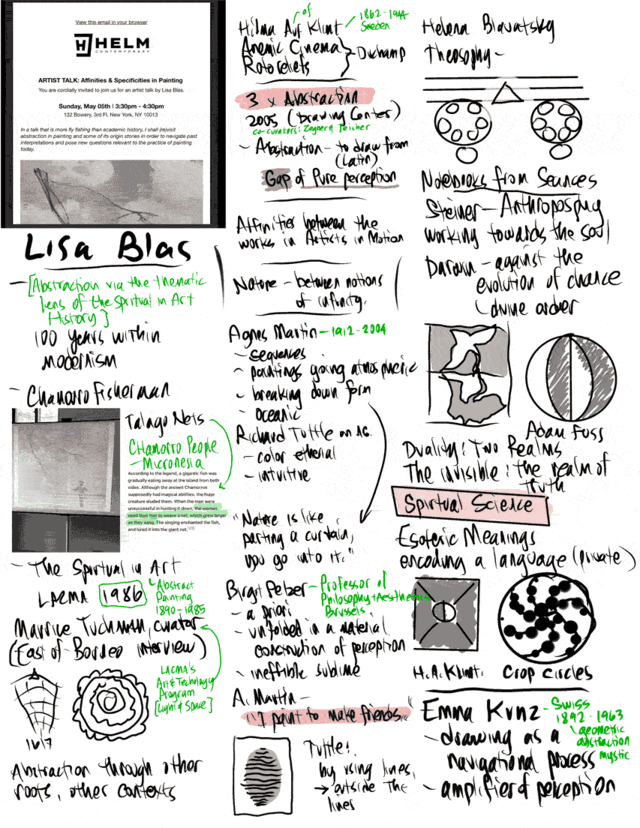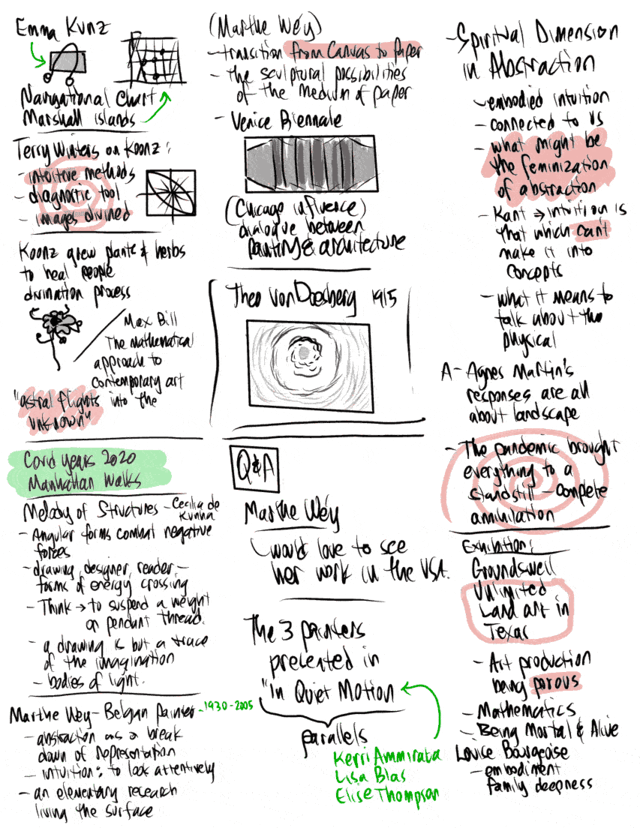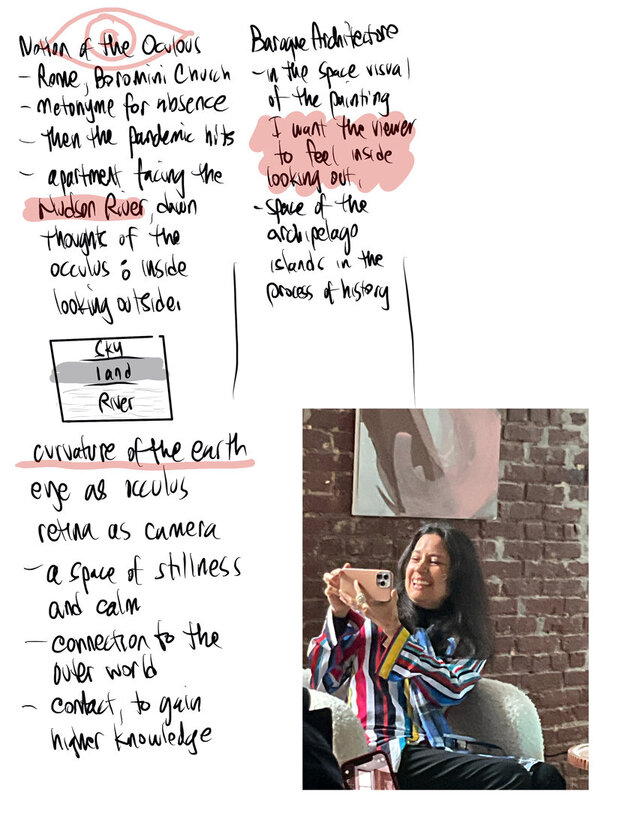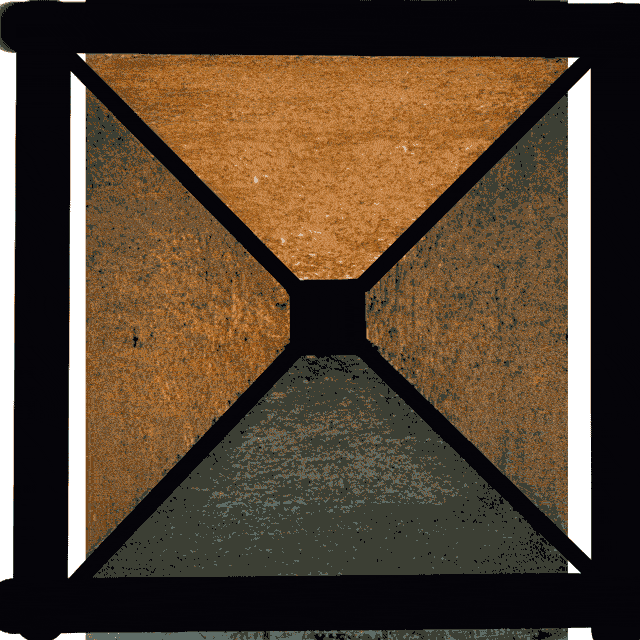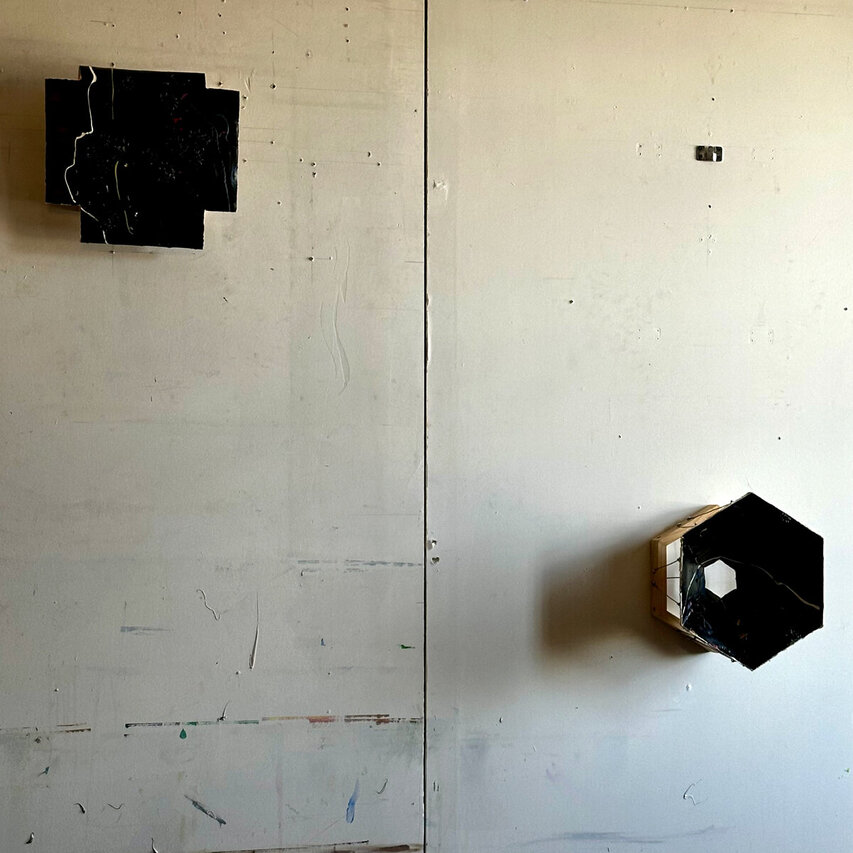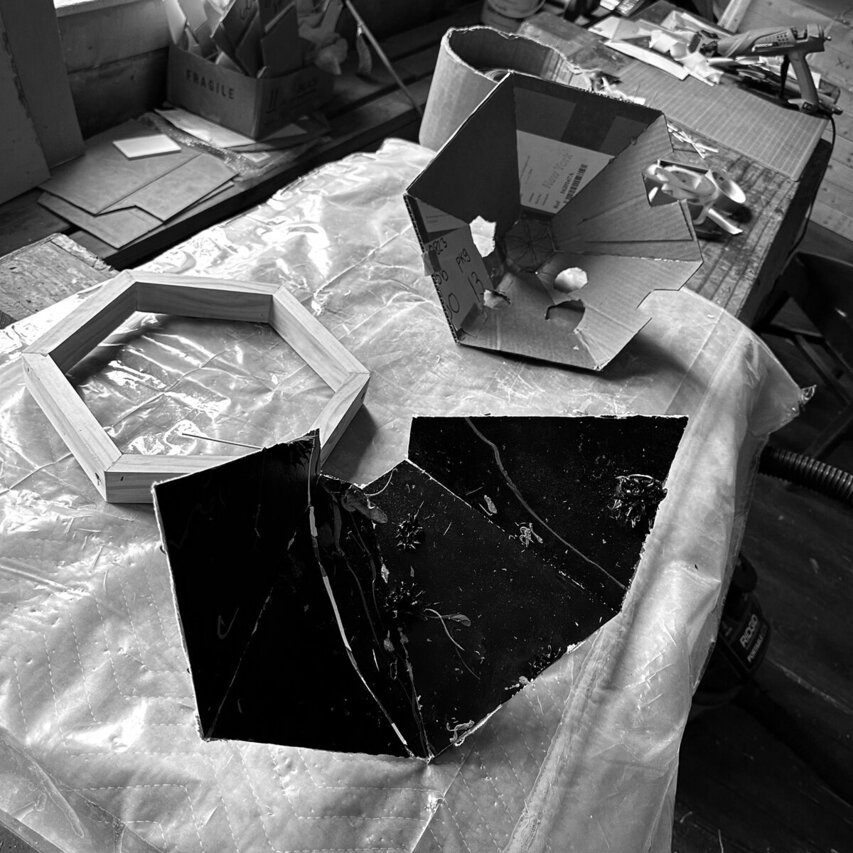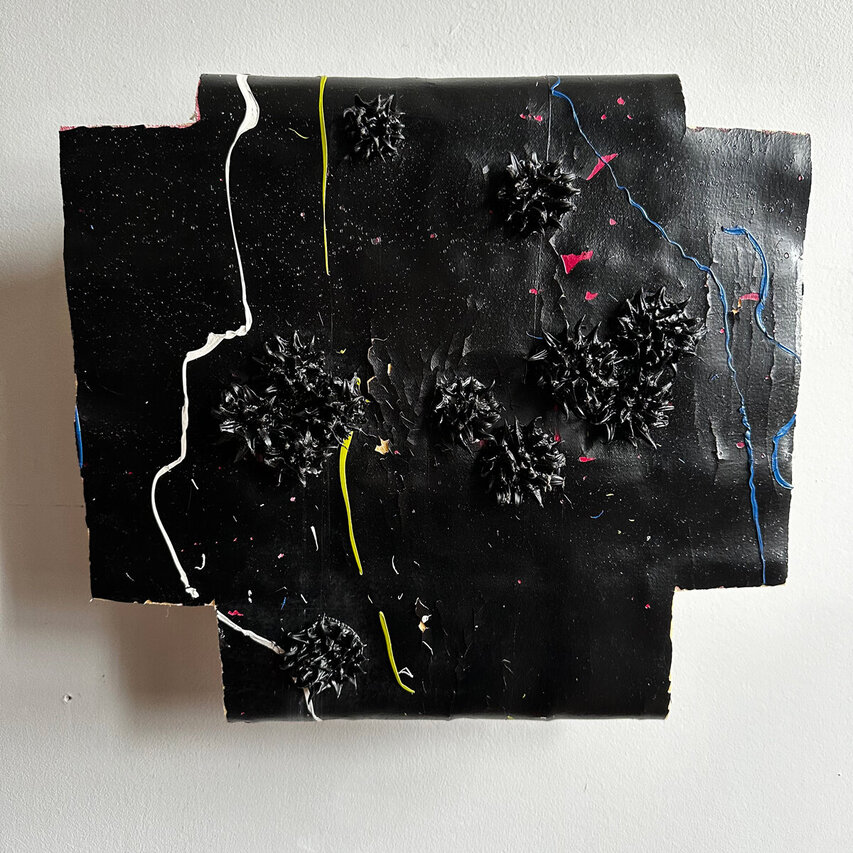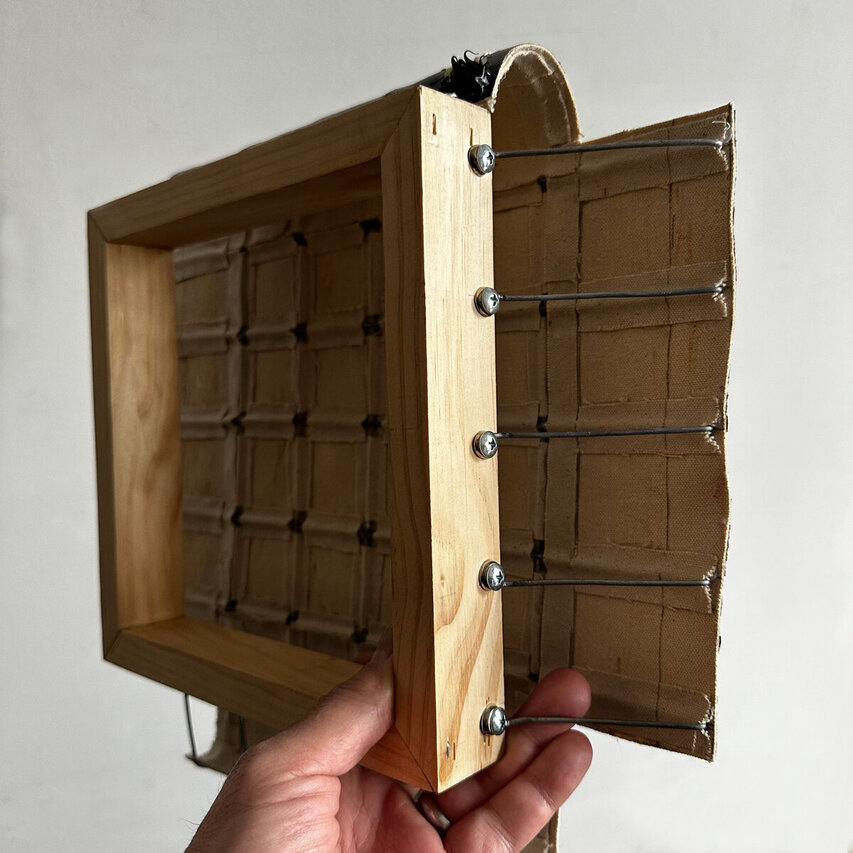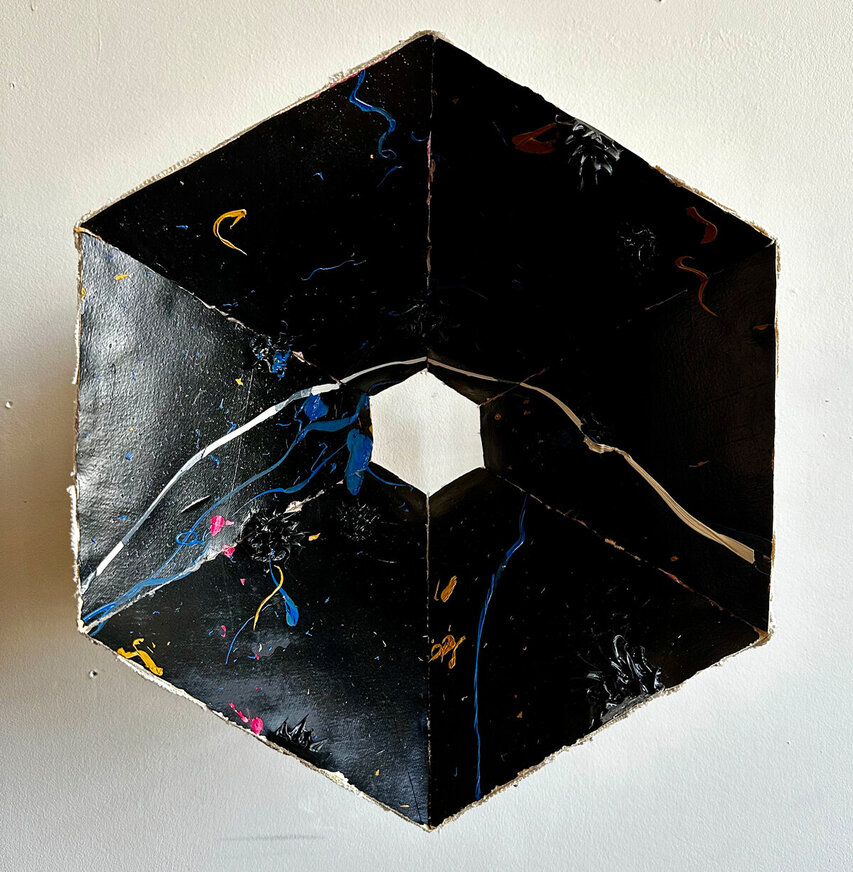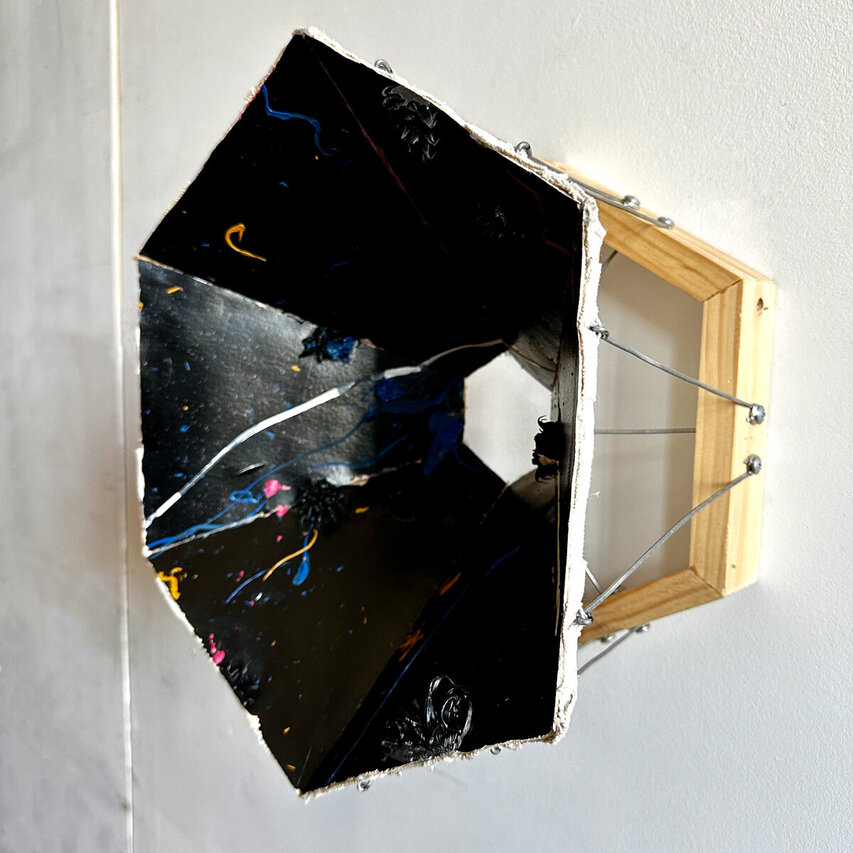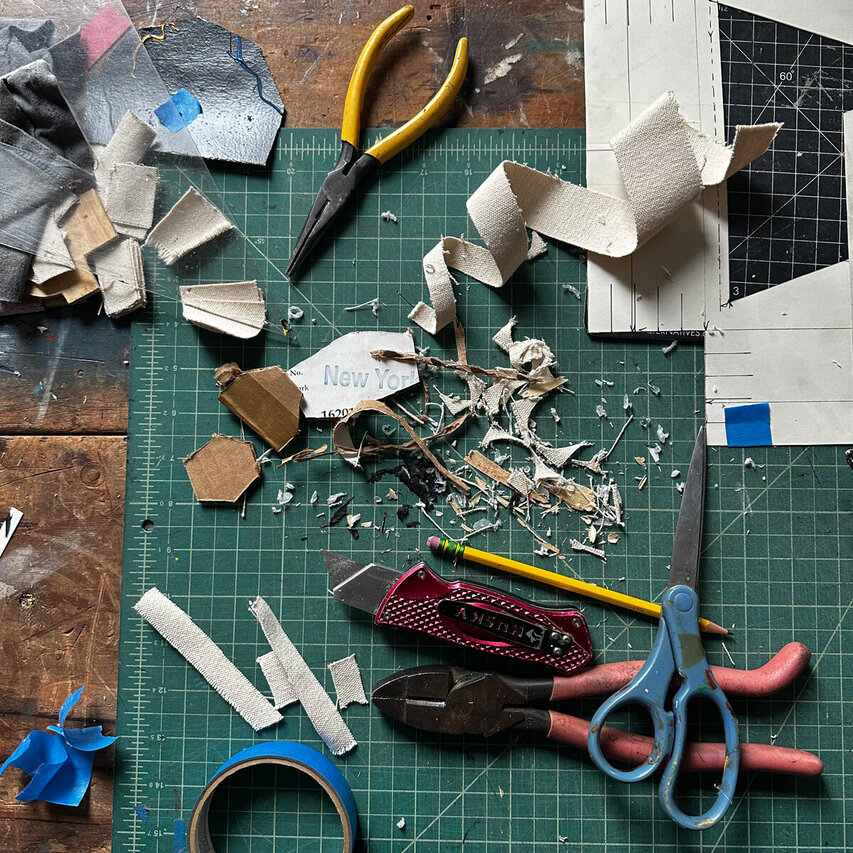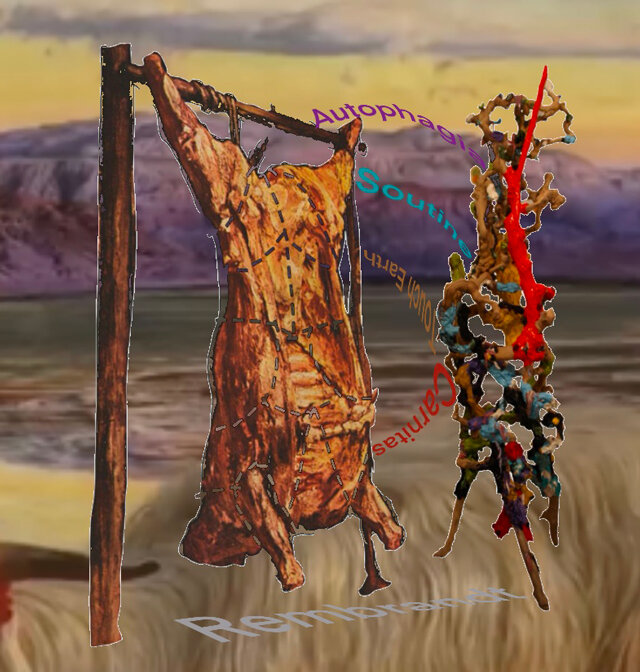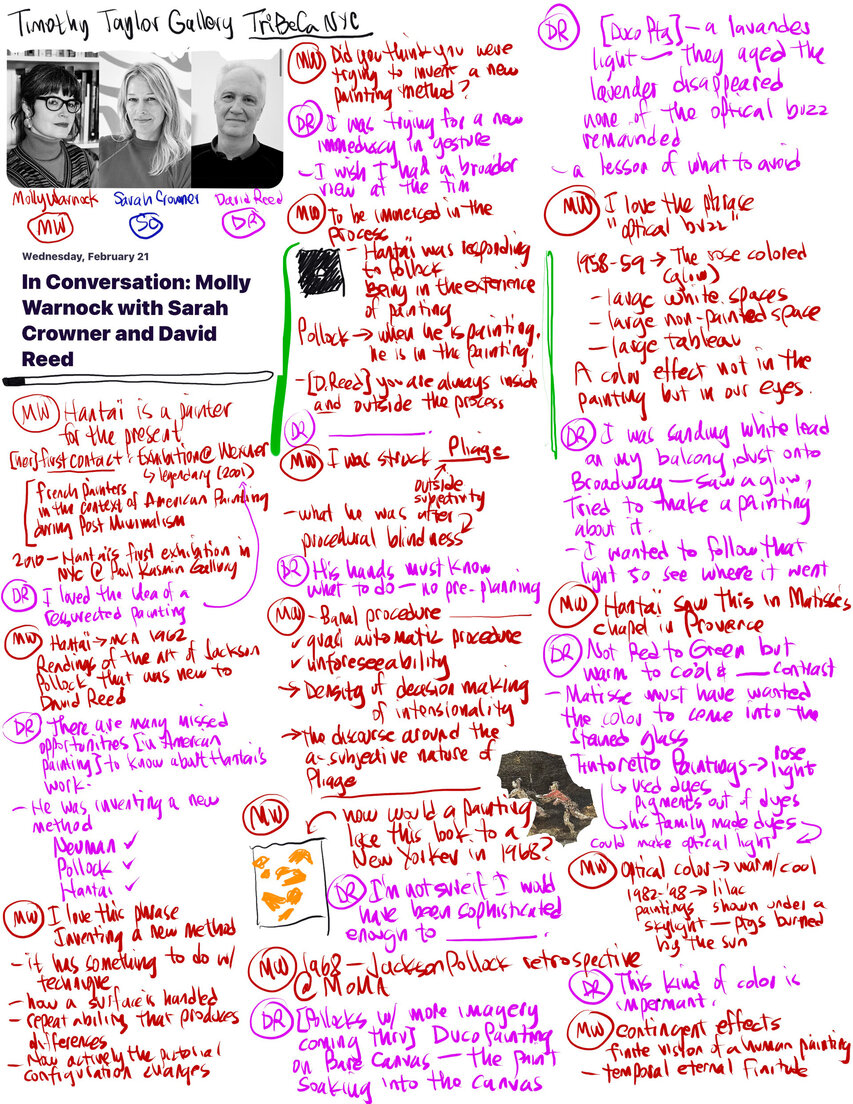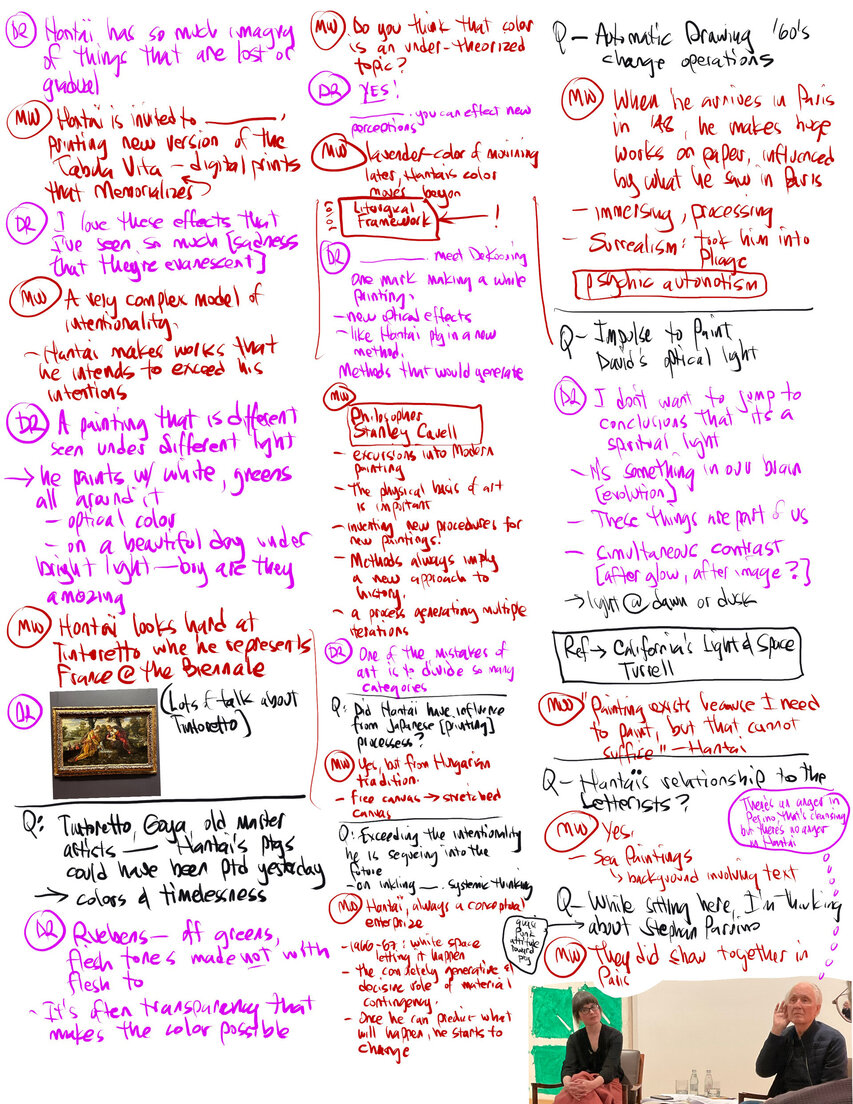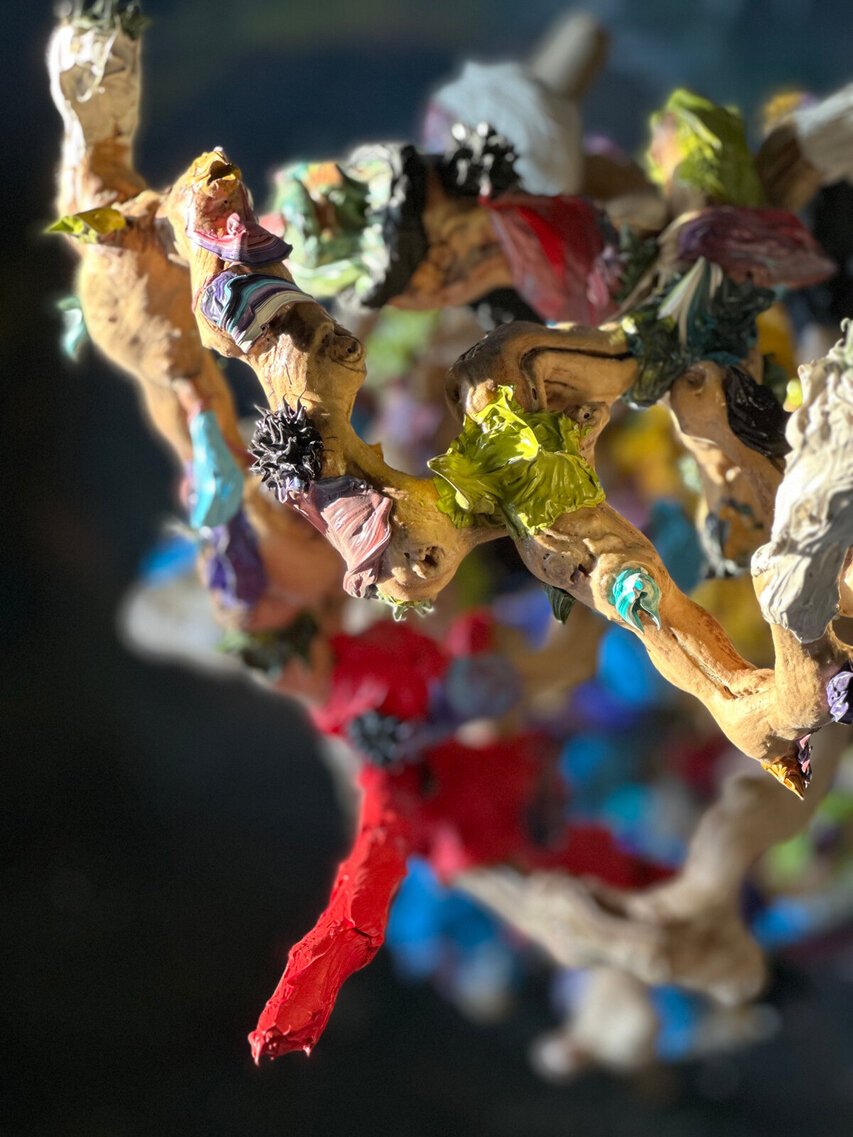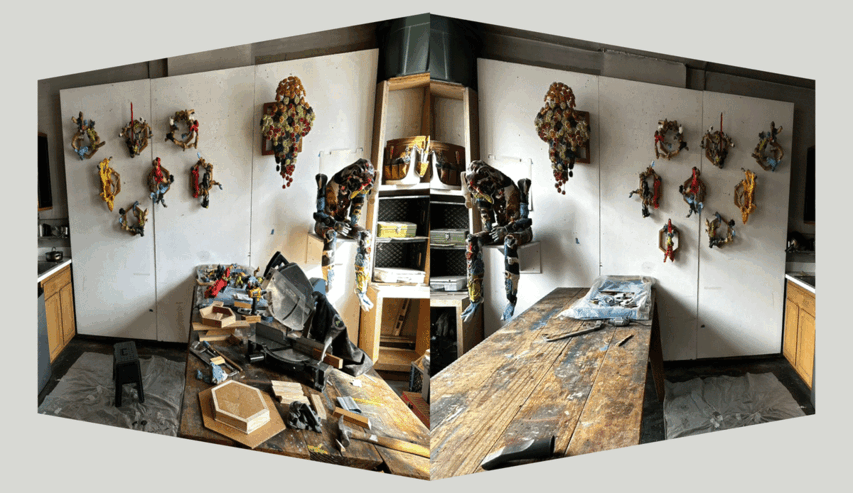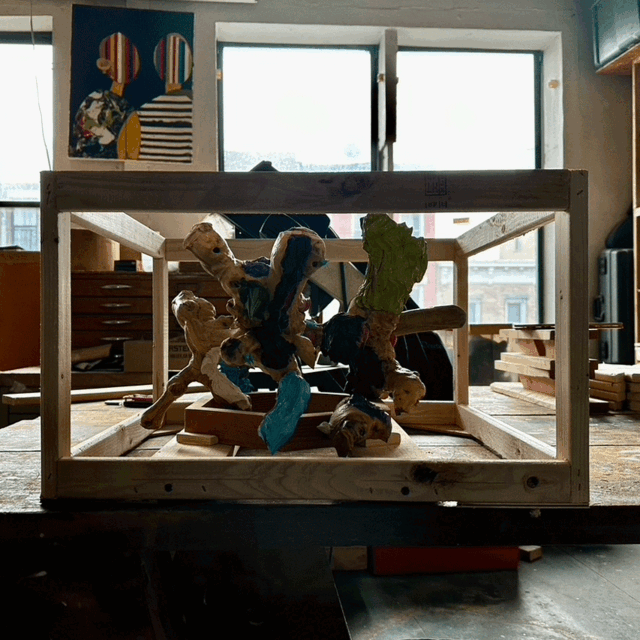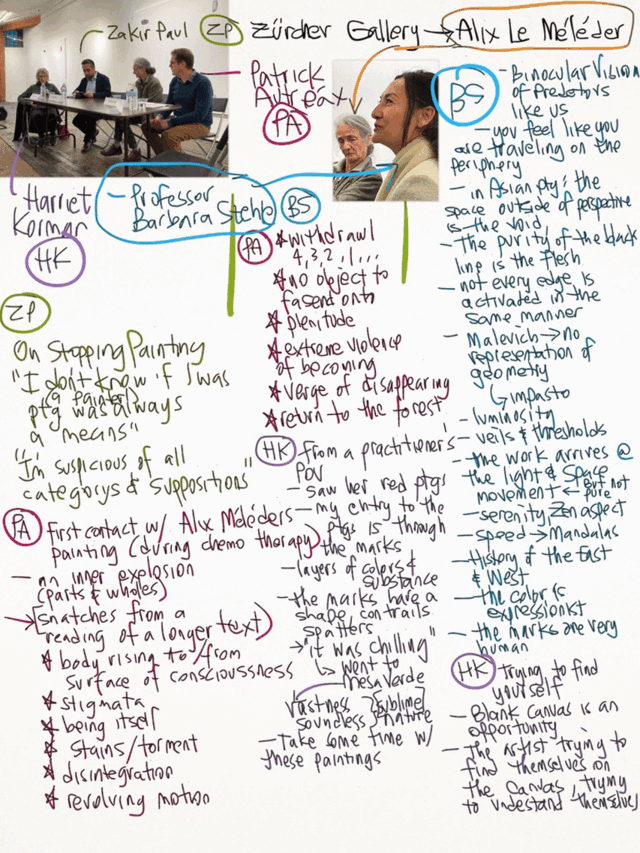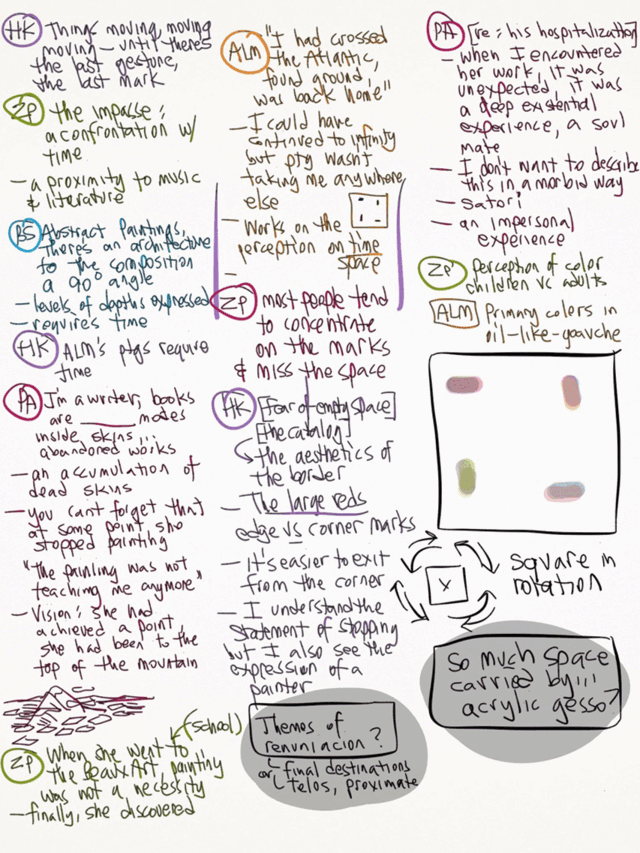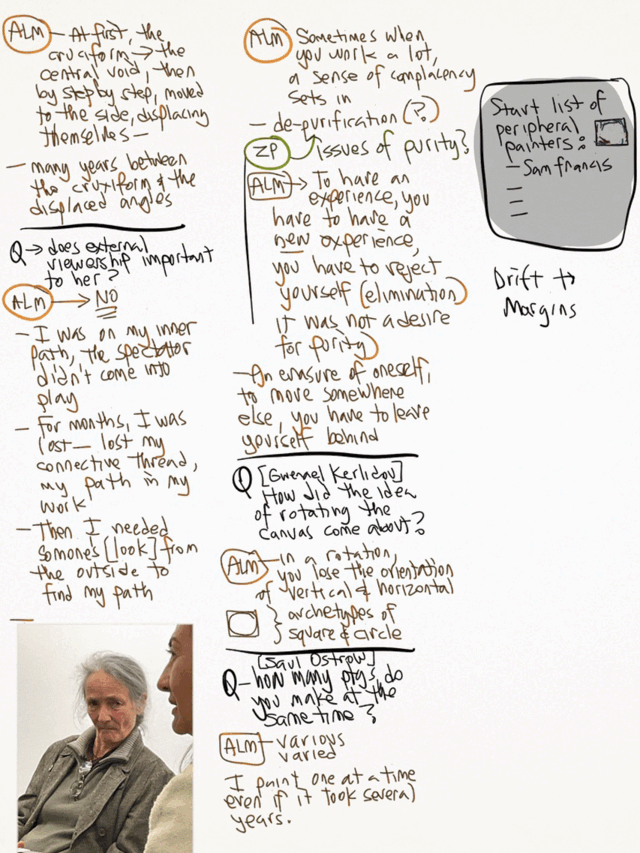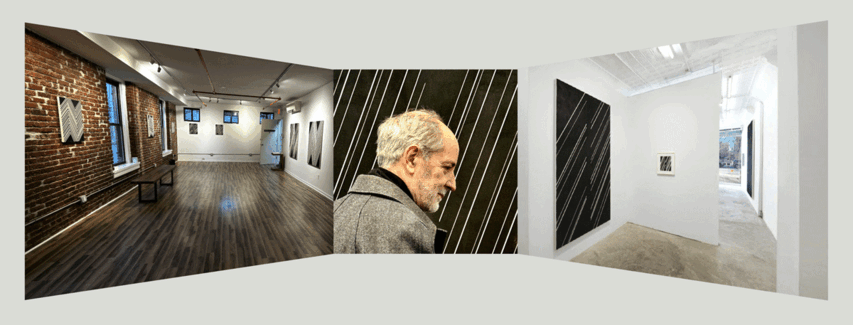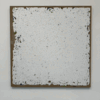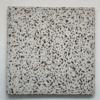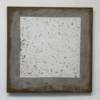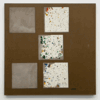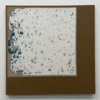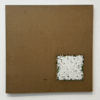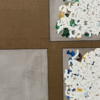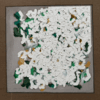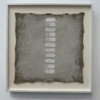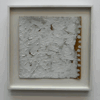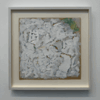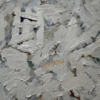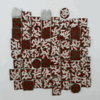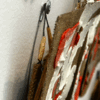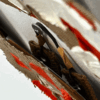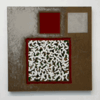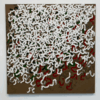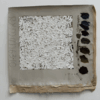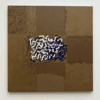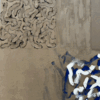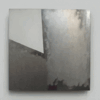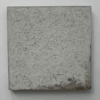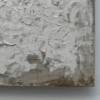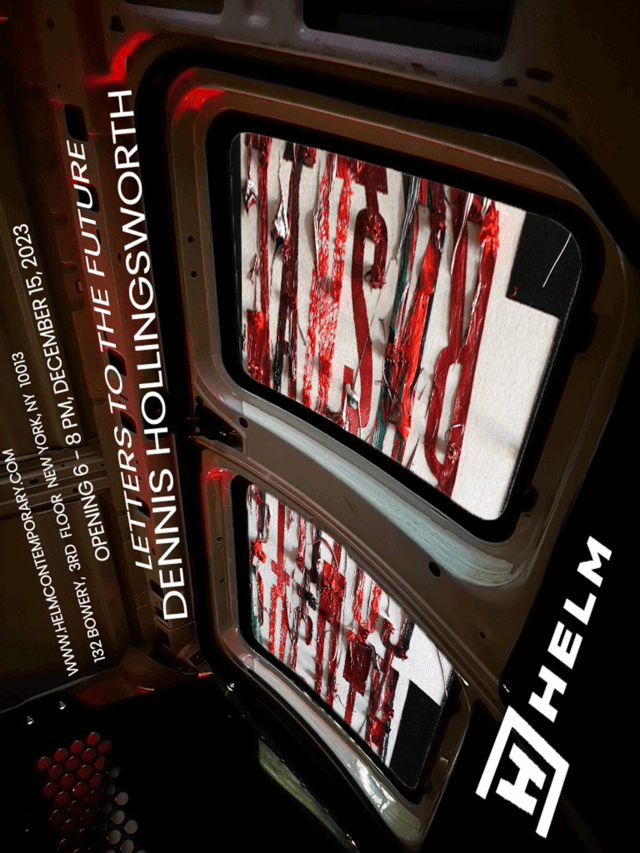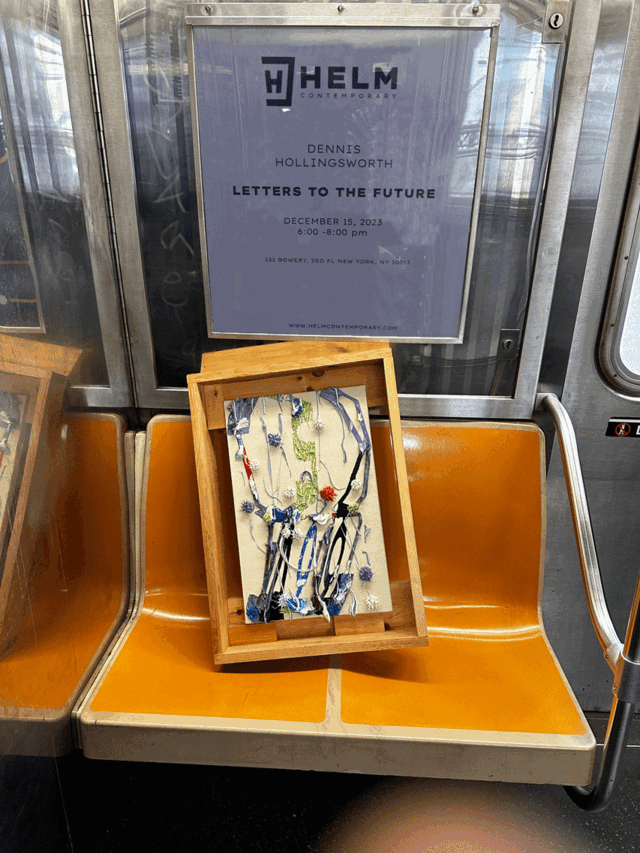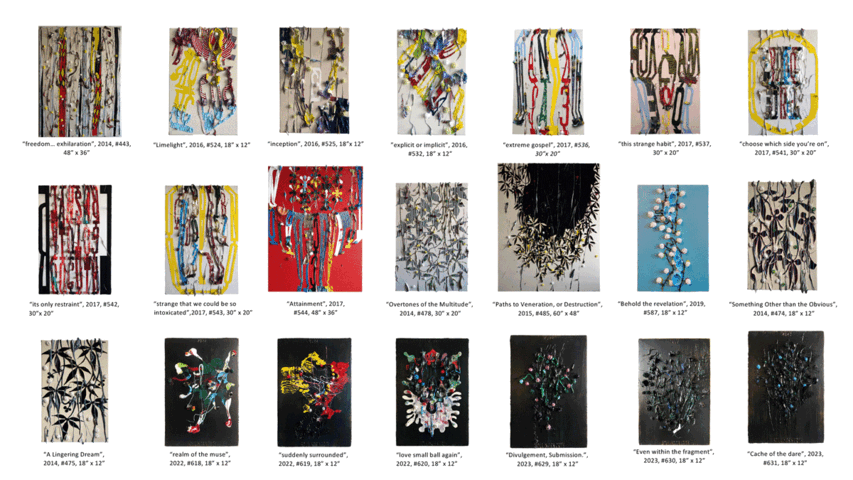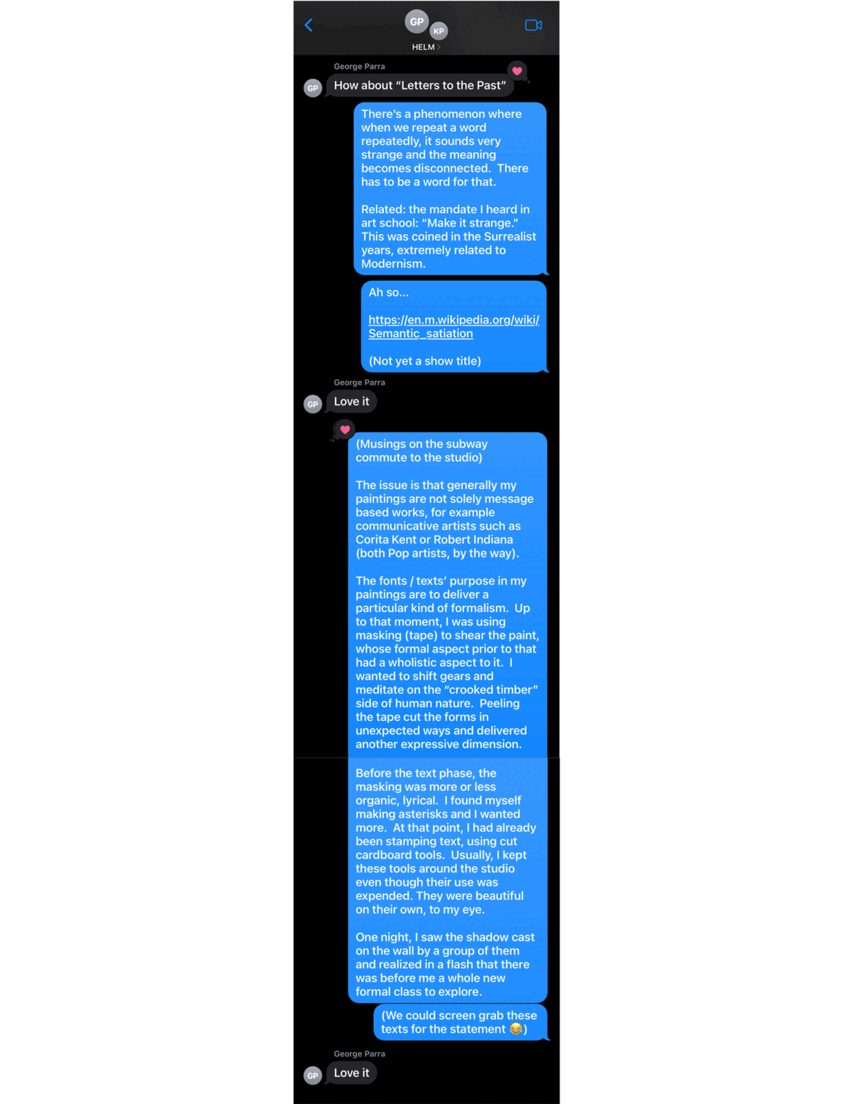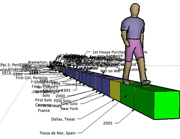June 3, 2024
June 2, 2024
Let's Call This a Bloom
An image appeared in my mind one day. A square, circled. A painting blooming from its support, a ring sprung a square, a frontal view displaced 90 degrees, the painterly seeped past the frontier of the canvas and into the wood and wire of the support. Petals spread wide, straining pistil and stamen forward, the gonads of painting glimmering for the horizon.
Later, associations. The first was a turbine. It was about the spin, it was about design, of blades about to spin but not yet so. Not yet. The piece was made, or well on its way. Wires implied motion strongly and yet they are fixed.
Spokes.
Bicycles.
Duchamp's Bicycle. He said that he made it just because he liked to see it spin. I'm in the middle of reading Thierry de Duve's "Clement Greenberg: Between the Lines". In it, a distinction is made, Greenberg's and I think de Duve's as well, between an art object appreciated aesthetically and one calculated in its' creation to impress. There must have been a moment preceding the manifestation of "Bicycle" when Duchamp found himself noticing how nice the spinning bicycle tires were, one moment here, one moment there. How better to hold that sensation aloft and away from the unpredictable circumstantial encounter than to fix it on a stool? Art material was all around him, freed from the specialty retail stores, ubiquitous. People said Duchamp was aloof, Duchamp had feelings, no matter how antiseptically there were categorized as aesthetic. Greenberg felt compelled to confine those feelings to the classical bins but I'm not yet entirely sure that de Duve does, even though he had charted very clearly the dangerous shoals of Art-In-General in "Between the Lines" and later more fully in "Duchamp's Telegram". All of this, I'm currently digesting.
About a week or two after I completed this piece, I sent an image of it to a friend, and his reply was a reference to the eclipse of 2024, the one everybody was abuzz about in the USA. Indeed, at the time of its making, the association didn't really occur to me. It seems a stretch, especially since I had made associations to celestial mechanics to art history in past blogposts. But yeah, the thought hadn't occurred to me probably because I didn't get swept up in the media hype at the time. And yes indeed, this is a great association. I love it, I've always had a fascination with astronomy since I bought an 8" Celestron in the 90's and learned that the sights we see of the universe in the media is quite different from what we can see with conventional optics here on earth. The eclipse, any eclipse is bound to be less than impressive unless one is directly within the path of totality, and that moment is all too fleeting as it is. But the association is wonderful, even if the reality of the universe is currently scrubbed of unimaginably vast distances between all celestial objects. Our abstractions of the world are quite vivid and spell binding.
May 20, 2024
May 14, 2024
Mighty Small

VERY happy to report my inclusion into this group show at Front, hosted by dear old friends, artists Sharon Englestein and Aaron Parazette.
FRONT 1412 Bonnie Brae St. Houston Texas, May 18 - June 15, 2024
From the website, a blurb:
Mighty Small brings together nine paintings by nine artists from around the United States. The aim of this exhibition is to demonstrate how much can be seen, conjured, and achieved within a modest frame. By contemporary painting standards the paintings in this show are small, but the effect of each one is expansive and reaching--even mighty. Encountering a small painting can be an intimate experience, as when you encounter it you are placed in the same proximity that the artist was in when they made it. Our constant processing of images on screens is too often seen as analogous to actually being with the thing the artist has made. To be with the actual painting is to encounter surface and depth, images and material, the ordinary and the mysterious, and potentially so much more. Each painting in the show provides this opportunity. Each is a record of idiosyncratic intentions and impulses, and each is a small but mighty moment.
May 7, 2024
Notes on Abstraction
In advance of a meeting next week with friends to talk about Abstraction, I created a note file* and dumped thoughts as they occurred to me during my day to day.
Then, I arranged them thematically.
A rough classification.
Here they are.
What is Abstraction?
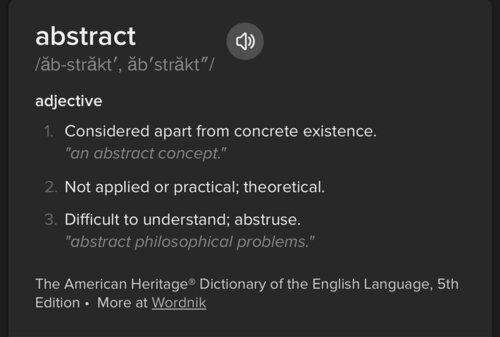
"The idea of "removing" or "pulling away" connects abstract to extract, which stems from Latin through the combination of trahere with the prefix ex-, meaning "out of" or "away from." Extract forms a kind of mirror image of abstract: more common as a verb, but also used as a noun and adjective."
The Remove
Duality
"...the original human nature was not like the present, but different. ...the primeval man was round, his back and sides forming a circle; and he had four hands and four feet, one head with two faces, looking opposite ways, set on a round neck and precisely alike; also four ears, two privy members, and the remainder to correspond. He could walk upright as men now do, backwards or forwards as he pleased, and he could also roll over and over at a great pace, turning on his four hands and four feet, eight in all, like tumblers going over and over with their legs in the air; this was when he wanted to run fast."
Mathematics
Mental Categories
Modernity
***
After listening to Lisa Blas give her talk about affinities and specifications in painting, she provides us with a rich vein to think about abstraction with. Adding another, probably more vital classification, using the framework presented by Blas:
***
Spiritual
*
*
*
*Another postscript: Thoughts on the fly. Usually, I flip out my phone while I'm commuting in the subway, the D train to Brooklyn, and catch the butterfly of a thought. This happens so often that it seems that if I want to brainstorm, I should just get to the subway station and let it rip.
April 27, 2024
Modernity and After Modernity
Below, the contents of my Notes file about Modernity. One of many sacs to be bled into this blog from time to time. Thoughts sometime beg to be recorded on the fly.
A Couple of Definitions:***
Modernity and amnesia. So much forgotten.
***
Awaking mid-dream last night. A legacy old place, fragmented, in a sea of mediocrity... A&P minimarts, Dunkin' Donuts a block away from an old Mission.
Are we the Last Mohicans?
Thierry de Duve's* Fine Arts, the Academy, Bellas Artes, Non-Art, Not-Art, Art-In-General... add to that another category, a faded simulacrum (receding image?) of Legacy Quality.
The fading Good lost in a sea of Bad.
Re-Member.
*At the moment, I'm reading Thierry de Duve's "Duchamp's Telegram: From Beaux-Arts to Art in General" at the moment. Actually, I'm devouring the book, consonant that I believe his thesis is with my thoughts about the emergence of Modernity, the relationship between Modernism and Postmodernism and Duchamp's legacy especially in the era that can be called Postmodern. I think we, living as we are in an emergent 21st century, have a responsibility to reflect on the 20th and make sense of it, to wrest ourselves from its' grip and attempt to define the terms of a successor epoch. I'm passing the three quarter mark as I'm reading his book, slow going since nearly every sentence I find provocative, marking most of the pages with marginalia. Very highly recommended.
***
"In the 60's, the art world blew open. "
-Peter Schjeldahl
***
"He does not present the great disruption of our time in terms of contradictory tendencies in human nature."
- "Francis Fukuyama as a Teacher of Evil". (Modern Age Journal)
***
Modernity sprang simultaneously as Modernism and Postmodernism. Bear in mind the blinding explosion of technology going on at that time. Electric light, (steam) power, trains, telegraph, weapons, medicine...
Hero and Anti-Hero.
Walk on the wild side. Sympathy for the devil. LES Fleurs du man The Counter-Enlightenment. Anti-Hero.
***
Modernity profits from ingenuity, spiked by greed and war.
***
You can understand what happening now regarding the decline of the West by simultaneously considering the cynical interpretation of Thucydides as "Might makes right" with Martin Luther's "Reason is a whore".
***
Consider acceleration, then consider deceleration.
***
After Modernity:
***
Anticipation of the future (Progressivism), a better world
Catnip tool for salesmen
Eschatology
Aching to get there
Making promises that are too hard to achieve, similar to this.
***
Modernity (both Mod & Postmod), a war between vertical & horizontal axis. Quoting myself:
To be Modern is to try to touch G-d via material means, and to be Postmodern is to point at everyday life via conceptual means.
To successfully succeed the 20th century, we have to heal the schizophrenic split, re-member the crosshairs, reclaim the cross, the synergy. If not a fusion, then a toggling.
On one hand, there's an ache for transcendence and on the other, an urge for dissolution. Order (the underlying principle of all things and the way such things come into existence) and disorder (individuation and pride). To think that both hands are members of the same body prompts for me an association or a mapping onto the first and second Law of Thermodynamics (a similar twin or chiral pair): the conservation of energy and entropy. The second is easy, themes of dissolution abound in postmodernism. In the first, I fiddle with the fit of the world where energy can't be destroyed and the sum of all forms of energy is constant with the endless becoming, the constant striving of the Modern system.
Recalling Lao Tzu:
The Tao that can be told is not the eternal Tao
The name that can be named is not the eternal name.
The nameless is the origin of heaven and earth
The named is the origin of the ten thousand things.
Ever desireless, one can see the mystery Ever desiring, one can see the thousand things.
Desireless and desiring. They are different in name.
Yet they are the same.
Modernism : The nameless is the origin of heaven and earth
Postmodernism: The named is the origin of the ten thousand things.
Another model to map: System 1 & System 2 thinking
March 21, 2024
Little Big Man
Prompted by an old friend, a possibility of making small pieces for an upcoming exhibition.
"Mighty Small", is the working title. I immediately thought of Dustin Hoffman's Little Big Man.
Some pics...
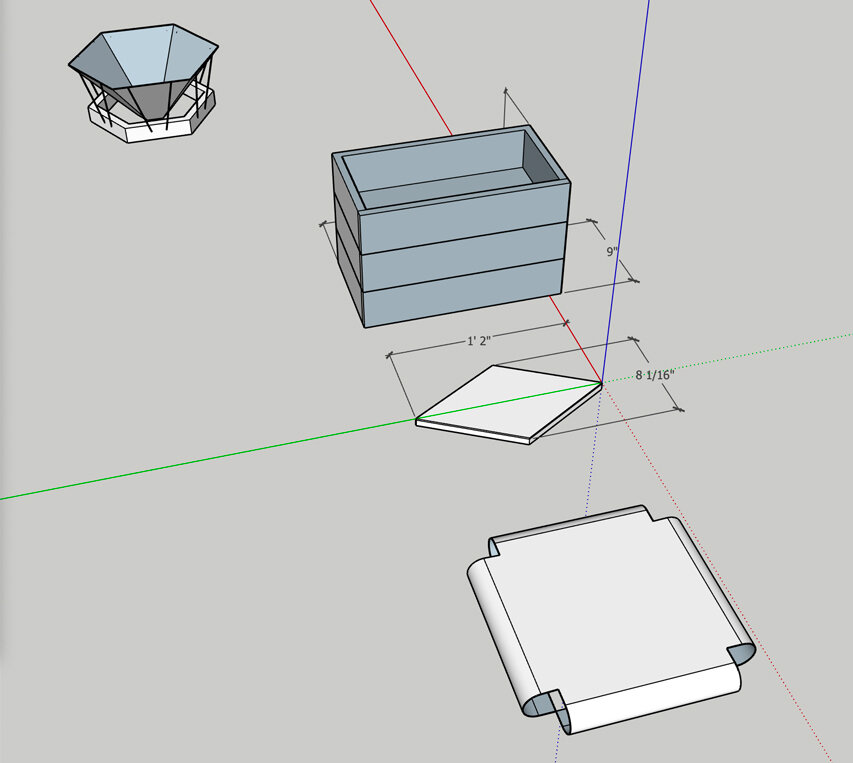

wide, almost
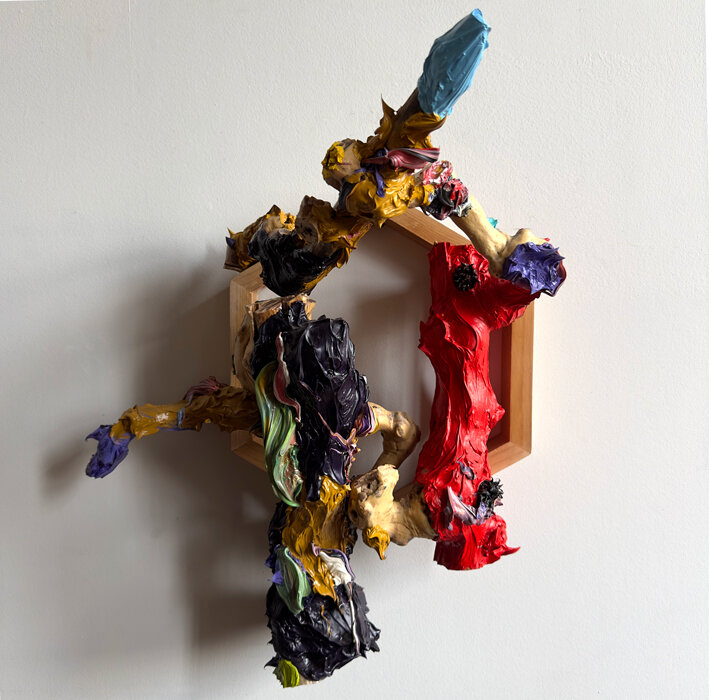
wide, almost
2024
PTG-642
18" x 16" x 9.5"
Oil on Wood
discover a new realm
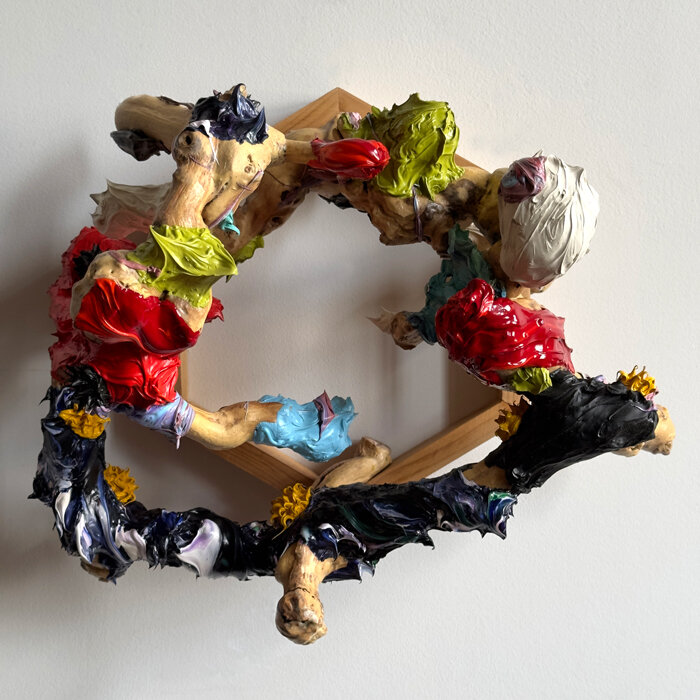
discover a new realm
2024
PTG-641
13" x 16" x 12"
Oil on Wood
saxophonist
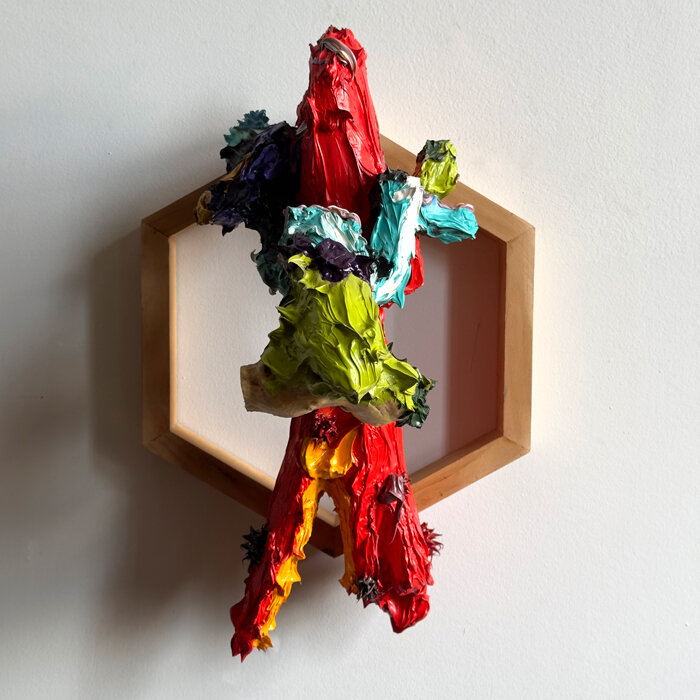
saxophonist
2024
PTG-640
18" x 13" x 11"
Oil on Wood
between precision and caprice
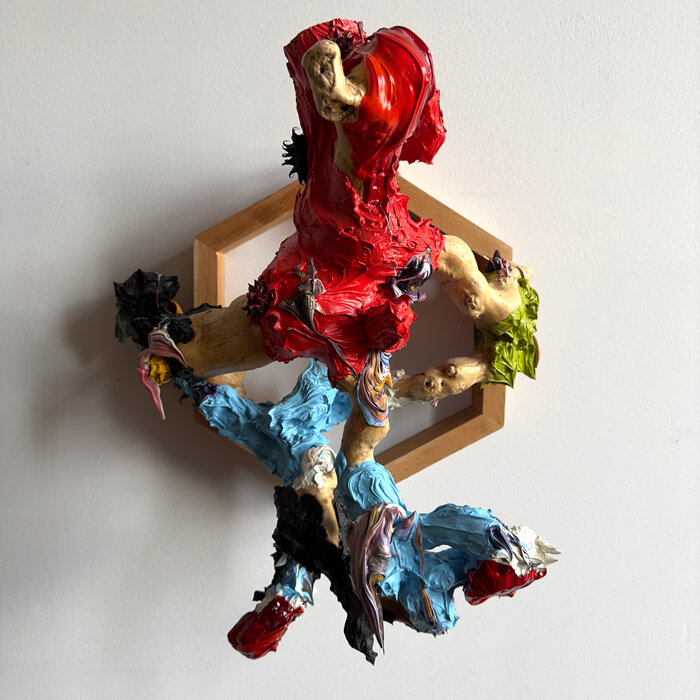
between precision and caprice
2024
PTG-639
Oil on Wood
Continue reading "between precision and caprice"readily to mind
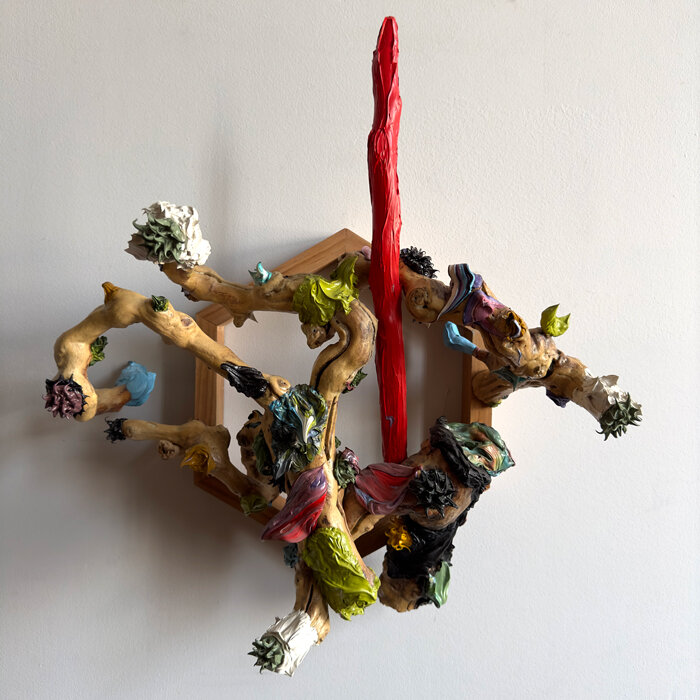
readily to mind
2024
PTG-638
18" x 16" x 9.5"
Oil on Wood
full throated
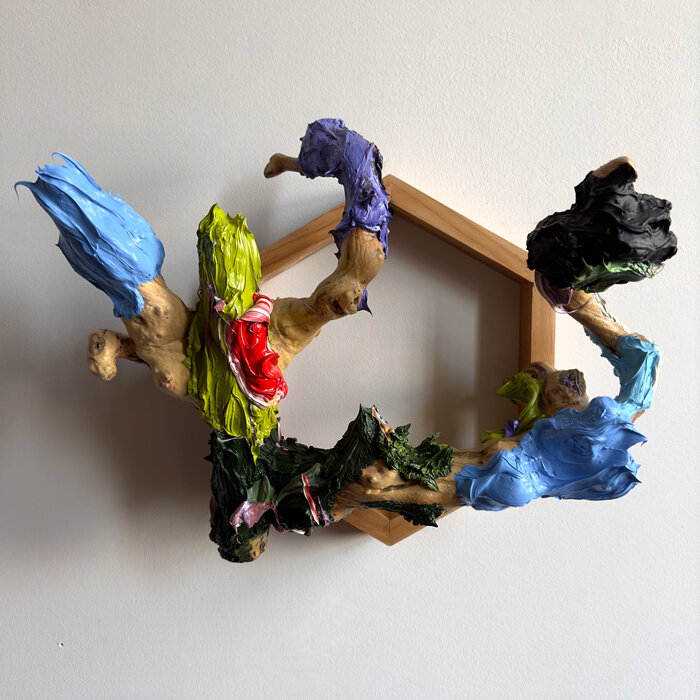
full throated
2024
PTG-637
13"x 16" x 7"
Oil on Wood
a gyration of the wrist until exhausted
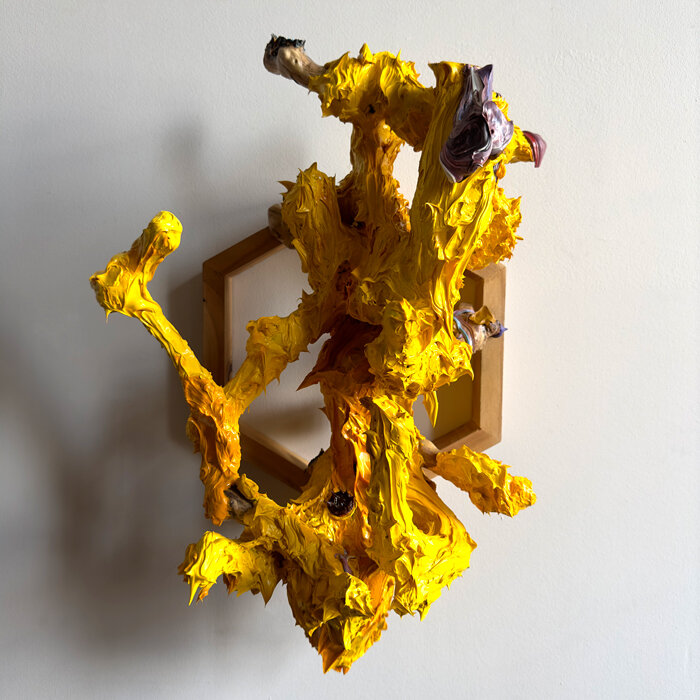
a gyration of the wrist until exhausted
2024
PTG-636
20" x 13" x 9.5"
Oil on Wood
sometimes with caprice
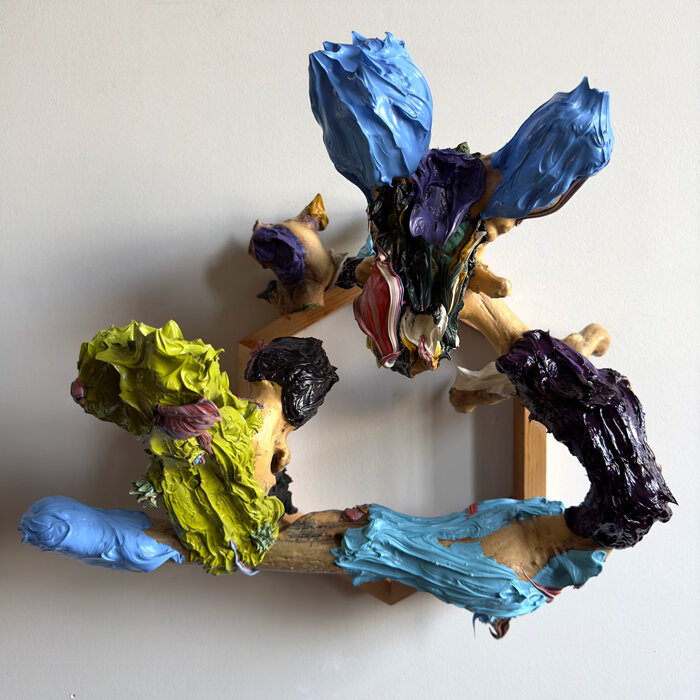
sometimes with caprice
2024
PTG-635
18" x 16" x 11"
Oil on Wood
March 6, 2024
February 22, 2024
Panel Discussion: Hantaï at Timothy Taylor Gallery
A few thoughts after the event:
First of all, it was delightful to have two heavyweights, one a historian of contemporary art and an esteemed New York painter, possessing his own unique pictorial language and a powerful oeuvre. The audience was full of smart talented artists.
Two topics were dominant in the room that night. Warnock dealt out the allover card and Reed, the color card. Via the allover, Warnock connected Hantaï to Pollock's drip painting* (via Neuman's zip painting, extending the lineage). She is known for her expertise in European painting but there's an interesting line item in her bio that goes like this: "...Director of the Clyfford Still Catalogue Raisonné Project at the Clyfford Still Museum in Denver, Colorado". So, she's steeped in the high water mark of New York Abstraction of the 50's and 60's.
Listening to Warnock's introduction, my impression was that issues of materiality and scale is the thrust of her concerns. Flipping through books on Hantaï (Warnock had just published one recently), black and white photographs of Hantaï in the studio are quite impressive. Evidently, Hantaï found studios in abandoned factories, the scale of canvas measure ten, twenty, thirty feet it seems, covering crumbling walls and floors. This was the post war era when populations were migrating from cities to suburbs, factories were retooling for peacetime, immense spaces were available to artists for the first time in history. This, coinciding with the emerging market booming consumer economy and the technological acceleration due to wartime innovation, you have the three significant drivers for post war abstract art.
As an artist who is heavily invested in letting materiality drive painting, the medium long since declared defunct and dead after the Pop/Minimalist/Conceptualist/Postmodernist carried forward Duchamp's Telegram (wink, de Duve, his new book that I'm currently reading), I was delighted to hear Warnock call for a new push for painting that focused on materiality. The thing is, such a project has to be cautious and mindful of what had happened in the long meantime.
Color was the other theme of the night. Reed talked about optical color, that color not in the world but in the retina or cerebral cortex. Or, maybe it's in the world but it's fugitive... Reed lamented that Pollock's use of Duco paint rendered a lovely lavender light that disappeared after the painting aged out. The words "optical color" resonated in the audience and subsequent discussion prompted me to reflect on California's Light and Space movement, James Turell and Robert Irwin specifically. Strange to hear New Yorkers lilt so many years after that era.
Yes, a very nice evening. Warnock, launching salvos like "...contingent effect... the finite vision of a human painting... the temporal eternal finitude..." and Reed, delicately savoring color, speaking of Tintoretto and Rubens.
*
*
*
NB: Regarding Pollock, I'm reading Carter Radcliff's book, a project commissioned by the Pollock/Krasner Foundation, apparently. You can read it here.
NG2: Coincidentally, I visited the Met's newly rennovated European Wing. It was delightful. Of the pics I snapped, Tintoretto caught my attention. Nice to hear Reed drop his name.

Panel Discussion: Alix Le Melédér at Zürcher Gallery
Alix Le Méléder, Paintings 1998-2011, January 16- February 28, 2024, at Zürcher Gallery, New York
Snips from the press release:In Alix le Méléder' s work, for every action there appears a requisite result of restraint or a negation. ... Alix stopped painting in July 2011. She had completed her work. The ethical and philosophical nature of her decision to stop painting comes from her work's internal logic. Alix could typically go on working but it would be meaningless. She felt she had nothing else to say, so echoing Herman Melville's Bartleby, she says "I'd prefer not to". Alix Le Méléder comments :
I realized one day that there was a desire for expression in my paintings and I wanted to free myself from it. I had to erase myself and paint again with color. I felt the need to blow out the space even more, that's why I came to the square format. And then to escape a kind of horizontal face to face with the canvas, I decided to rotate it."
This is my first exposure to le Méléder's painting, it was fortunate to be able to attend the panel discussion on such an occasion. Much of the press release is in the artist's own voice, it was a challenge to find the transition between the gallery's words and hers. I'm not sure why this is significant, but a comment about it feels necessary right now. Evidently, le Méléder spent a lot of time in India and has absorbed Hindu and Buddhistic philosophy to a serious degree. As a result apparently, she glories in the extinction of desire, self, and the liberation of the legendary cycle of death and rebirth.
From my perspective, within the lens of her life, oeuvre and personality, she had recapitulated the theatrical eschatological death wish inherent in Modernity, in both manifestations Modern and Postmodern... a turn of the volume knob on the control panel of painting. Click, click, click until the final snap that powers down the unit off. Painting is her vehicle to a destination called satori. Once she got there, she didn't need the taxicab anymore.
Here's the last lines of the press release in the voice of the artist:
I felt all along the way a great closeness to India in my relationship to the world, to life and to nature; Painting took me on a kind of initiatory journey with its experiences and obstacles, with its phenomena that brought me to awareness. Each step of this journey had to be based on knowledge and not on a simple intuition. These paintings are the manifestations of a phenomenon of shifting consciousness between death or non-being and birth or re-birth. To reach this state, I had to work on a negation of myself, a kind of annihilation, a necessary passage to go towards the unknown.
February 3, 2024
David Rhodes, Doubled
David Rhodes | Aletheia , January 18 - March 3, 2024 HIGH NOON GALLERY, 124 Forsyth Street, NYC
David Rhodes | Partita , January 26 - March 1, 2024 HELM CONTEMPORARY, 132 Bowery, NYC
This is a great NYC month for my friend David Rhodes. Two solo exhibitions are up centering on David's paintings are up in the galleries of NYC this month. This is on the heels of a fine group exhibition that he was included in, Beyond the Surface, Westbeth Gallery, New York. A great painter, fine writer, a sensitive soul. David included me in a group exhibition at Hionas Gallery when I first moved to NYC in 2012-13. I met Peter Hiionas and consequently met the artists orbiting his space, a group of intelligent and committed artists all.
"David Rhodes: Reconfiguring the authorship of a painting", Two Coats of Paint, by Adam Simon
"David Rhodes: Alethia", The Brooklyn Rail, by Saul Ostrow
The other day while enroute to my studio in Brooklyn via the D Train, I was thinking about how this moment was special for David, of how we can see David's overall painting endeavors in a dimensional way because of the several venues that now feature his work. So I wrote the following thoughts out. I'm pasting them raw without any edits or refinements.
On The Two Rhodes Exhibitions
*
*
*
"He was a sceptic, he was young, abstract, and therefore cruel."
― Fyodor Dostoyevsky, Crime and Punishment
*
*
*David Rhodes is not young
Is David Rhodes a skeptic?
David Rhodes is an abstractionist.
David Rhodes is gentle.Alethia: uncovering (truth?) revealing? The subtleties of Heidegger, uncovering the blind side of the Western psyche. The central motif in the High Noon exhibition is the space slicing vertically (and of course diagonally, a constant instrument in his paintings), a parting of curtains, a reveal. Is what is being disclosed is actually "The Origin of the Work of Art"? This suggestion is heavy. Is the clearing for the appearance of things in their world, a setting of a stage?
Partita: music composition, originally referring to a single instrument, Bach used it as a synonym for a suite, a collection.
One, a parting. The other, a gathering.
One, a revelation. The other, an interweaving, a society.The intervals between lines, the thicknesses of lines: we see how they range from edge to edge, we see the frequency, but a pattern among them is elusive. It suggests a signal but resists a decoding. The pattern of lines suggest frequency and frequency suggests waves. A two slit experiment suggests an observer is present, waves collapsing into particles, particles acting in concert as waves.
The ground is as noumemal as a Malevich black square. It is as if we have fallen into the Last Future. (Zero Ten.) The blackness is velvety, there is no color change from one canvas to the next except for a certain shine and a shifting palpable quality. The eyelids close with not even an afterimage in sight... or alternatively, the rays across the inky depth are flashes of an optic nerve. Two moments before and after the performance: first, the silence before the spotlight alights and second after the applause dies. Both are inky black. Both are full of what is to come and what had been.
*
*
*
PPS: More thoughts arise. An artesian well, Rhodes' work is.
Two categories follow, the issue of representation and abstraction and "fit for purpose":
Rhodes' painting is simultaneously presenting (representational) and non-presenting (abstraction). It is both at once like other things and its own thing. At what point is this simultaneity in balance and in conflict? At what point is this frozen? At what point is this a cunning entrapment? At what point is this abundance or depletion?
***
Form Follows Function, as the famous Modernist said. "Fit for purpose" is a British phrase I learned while binging BritBox. There's a classically Modernist economy of means operating in Rhodes' work. Tape goes down, paint splashed on, tape goes up.
Done.
No fat.
Lean.
* Numberless are the world's wonders / But none more wonderful than man / Words and thought rapid as air / He fashions for his use / And his the skill that deflects the arrows of snow / The spears of winter rain / From every wind he has made himself secure / From every wind he has made himself secure / From all but one ... / all but one / In the late wind of death he cannot stand
January 11, 2024
December 19, 2023
PRICELESSNESS
There exists in the real world of art, an operational paradox: the extrinsic value of art is based on an invested intrinsic value. Intrinsic value is further based on an idea, a conviction, a leap of faith about the priceless.
The price of art depends on the unwillingness to part with it.
The exigency of life eventually overcomes the ideal and someday the sheer unwillingness to part with an object will meet a price that conquers it, which in turn ratchets the price of art, reifying its worth.
Continue reading "PRICELESSNESS"Robert Ryman: 1961-1964
Robert Ryman: 1961-1964
David Zwirner Gallery, 537 W. 20th Street, NYC
November 9, 2023--February 3, 2024
Goya, Duchamp and Ryman.
If I were to cite the artists who had influenced me, these are the three that come readily to mind.
Francisco José de Goya y Lucientes, Henri-Robert-Marcel Duchamp and Robert Ryman.
It was Goya's painting, "Saturn Devouring His Children" that had me spellbound as I stood before it when I was thirteen years old. I knew deep down inside at that moment that I would be an artist, a painter. I have recounted this event elsewhere in this weblog.
In the history of Modern Art, Marcel Duchamp is impossible to ignore. Postmodernism wouldn't be the same without him, perhaps it wouldn't have existed. I understand his polemic against painting as "merely retinal" as the necessary artifice of argumentation in order to move into a more conceptual direction in art. Apart from his stature, two aspects stand out for me. Duchamp is the exemplar of the ultimate independence of the artist. Chalk it up to anarchism or his reading the books of Max Stirner, Duchamp followed inspiration whenever it hit him and wherever it led him. The second recourse I found to Duchamp was regarding chance and the fugitive nature of materials. When I discovered the malfunction of my use of titanium white pigment around 2013, it was his acceptance of the damage to his Large Glass that inspried me to steer into the skid and discover a new realm of painting that I would have never considered otherwise. I've painted a few paintings in direct tribute to Duchamp. If you are reading this before the end of January 2024 and want to see an example, I have one hanging in my solo show at HELM Contemporary, 132 Bowery, NYC.
But this post is supposed to focus on Robert Ryman, and there's an excellent exhibition in town featuring his painting at David Zwirner Gallery: Robert Ryman: 1961 - 1964.
In the summer of 2017, I started to act on gathering thoughts about the shear weight of my paintings, typically canvas stretched over wood panels. I began daydreaming about what a lighter support could look like, and I thought of Robert Ryman's treatment of the object nature of painting. Already, the nature of my project was to focus on the fact of physical paint, to derive a formal vocabulary from impasto that rivals, that adds to the optical nature of color, line, tonality, etc. Already into the base assumption of my painting, the doorway to what I started to call the Ryman Code was open, waiting for me to walk through it. In Ryman's works, every aspect of a physical painting from the paint in each layer, to the linen/canvas, to the [snip: not the wood, more about that later] wire, to the brackets, to the screw on the wall... each physical component was distinct and expressive.
A non trivial detail in Ryman's rather thin bio is his experience as a jazz musician, a saxophonist, when he had first arrived in NYC in 1953. Lost somewhere in my YouTube stream is a video about Bill Evans talking about his work in the early 60's, not coincidentally during the period of time Ryman was making those paintings in the Zwirner show. Evans talked about how he wanted to assemble a group of musicians and play in such a way that each one would be distinct and full throated. This is exactly Ryman's program.
Let componentization be a word. Each component in the entirety of Ryman's physical paintings sings full throated. Notice that when people refer to painting, the support falls away. Painting in common everyday parlance nearly achieves the disembodied two dimensional flatness of Greenbergian fame. People don't generally consider the material fact of painting. Paintings are habitually considered to be windows to an imagined place, but for Ryman, the material existential fact of a painting in all of its aspects, parts and pieces are the place, the destination of his works.
Within the realm of paint-on-canvas, components reside. In this exhibition, during the years '61 - '64, there were slippage between the parts and pieces: pencil lines, mask, washes, color daubs and finally / famously, his white daubes. Even his signature was an equal player in the band. All are discrete, and almost, almost but not quite, interchangeable. There is slippage between layers, slippage between components and slippage between precision and caprice.
But for all the apparent movement, the ranks stay in order. Ryman's painting is like an exploded diagram. Paint is not used as the adhesive to a wall, supporting a facture of wires, brackets and linen. All stays in place, Bill Evans is still the band leader. Even within the realm of Ryman's painting proper, the troops remain in ranks. Pencil plans may change and move laterally, but they stay in the rear. Washes don't veil. Curiously, in the painting proper, there is a whole adventure of color daubs that is concealed with white paint, sometimes with precision and sometimes with caprice. This layer is almost like Ryman's secret life, his weekend in Vegas. But what is common to layers colored and white is a consistency of brushload and expenditure. I can see him in his studio, in my mind's eye: brush in hand, a charge from the palette, a gyration with the wrist -the cameraman cuts to a close up of his unusually large glassy spectacled eyes, wide almost to his temples, crowned by his owl-like wizard eyebrows- a gyration of his wrist until the exhaustion of paint material. Reload.
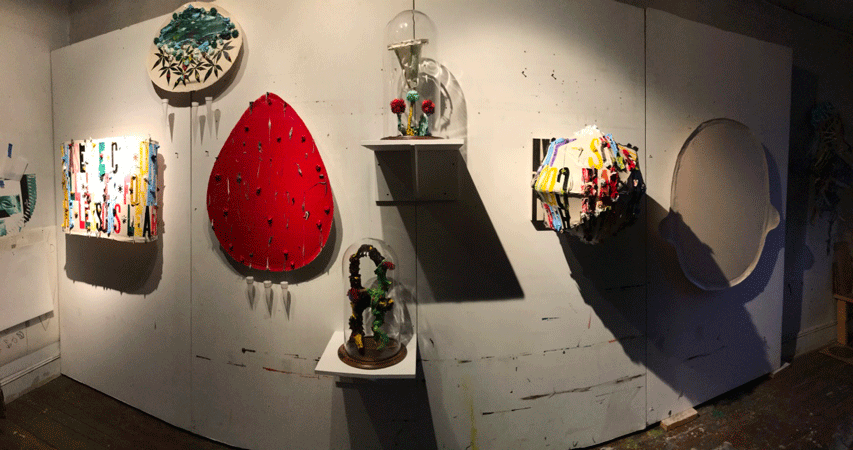
(Studio: December, 2017)
*
*
*
PostScript 1: Was Ryman the proto-autist?
PostScript 2: During the seven years from arrival to NYC to his exit from MoMA security service, what was his making? I read somewhere that he noodled paint on museum postcards. Reminds me of Richter's paint spattered Polaroid photographs. Note that there is no arc in Ryman's oeuvre, or at least it's really, really flat. Not like Rothko, whose early works are starkly different from his mature paintings. His arc is like a climb up El Capitan.
PostScript 3: Ryman never treated the wood stretchers like the other elements in his work. They're missing. I wonder if this is because he never had a chop saw in his studio?
December 15, 2023
Kismet 4 Social Media
Three examples of how I like to approach social media. I don't know what irritates me more, Instagram's cookie cutter format or the artists who capitulate to it. I keep asking myself, WWMRD? What would Man Ray do? I'm not saying that what follows below are up to this standard, but it's a standard that I aspire to. It's all an about a mix of kismet, being alert to special encounters, stretching the parameters of media and simply having fun, adventure with it all. Two contemporary exemplars that immediately come to mind: Raymond Pettibon's Twitter channel and Dennis Cooper's weblog.
Enough said about that. Three examples follow.
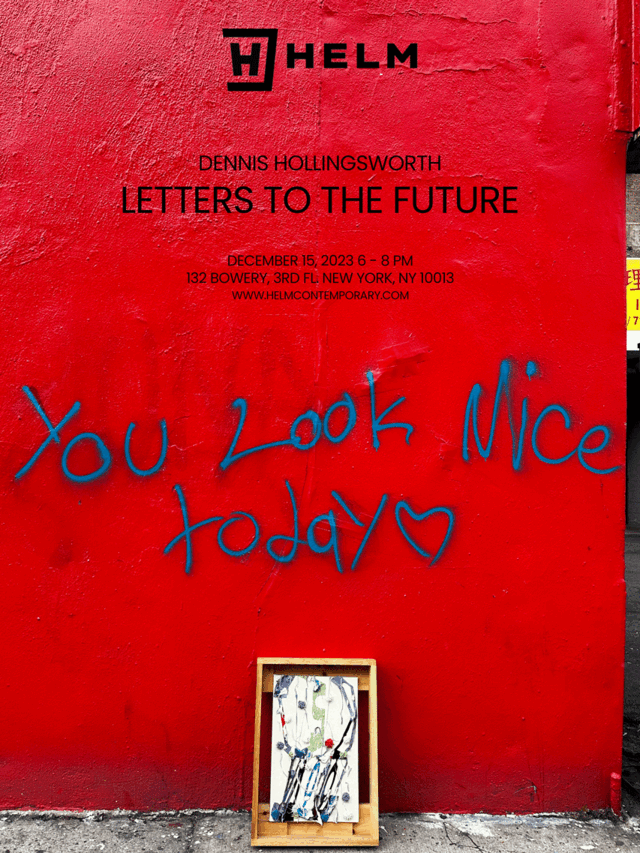
Inception
This is the initial selection of works for Letters to the Future. Subsequent modifications challenged the curatorial premise, but so far the logic holds: the text paintings and their precursors.
November 11, 2023
Opening tonight in the Bowery.
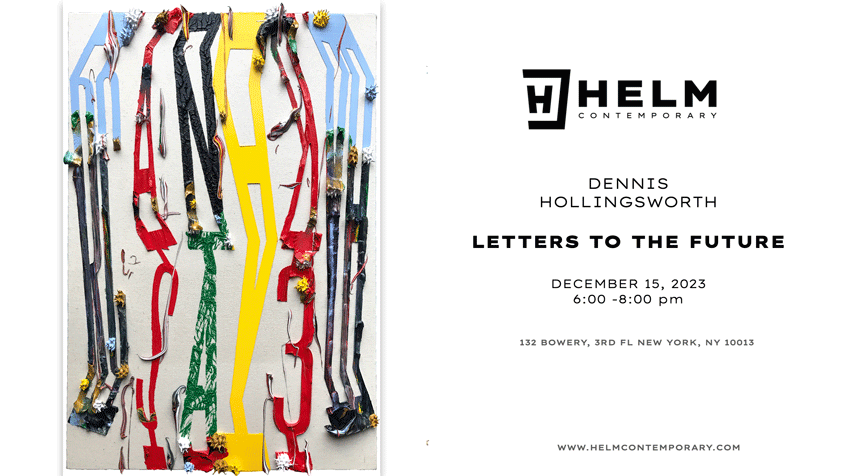
Tonight I have a solo exhibition of paintings whose subject is centered around the period when I was painting text based works, in and around 2016.
HELM Contemporary is a new gallery founded by collectors of my work, George Parra, Karina Aergudo and Jian Liang. Around two years ago, they started to discussed the possibility of starting up a gallery whose business plan is based on their own experience as young collectors encountering the art market and knowing that there are a lot of people like them, accomplished professionals who have a native appreciation of art, who have been awakened to the adventure of art but who are to a significant degree, daunted by the formidable, mandarin, byzantine, elitist Fine Art world. Their business plan is a simple and direct matching of supply and demand: there exists a pool of accomplished artists who have yet to be granted representational entry to the realm of the Mega-Galleries and there exists a pool of potential collectors who have yet to be granted entry to the realm of the Mega-Galleries. They feel they know enough to start, that time is of the essence (the captains of the Mega-Galleries are keenly aware of this as you might learn with cursory research), and they know that there is much to learn going forward. They're willing to grow on the public stage, and I've seen them grow from my point of view. Intrepid.
Following posts will color in more background in the making of this exhibition.
just so
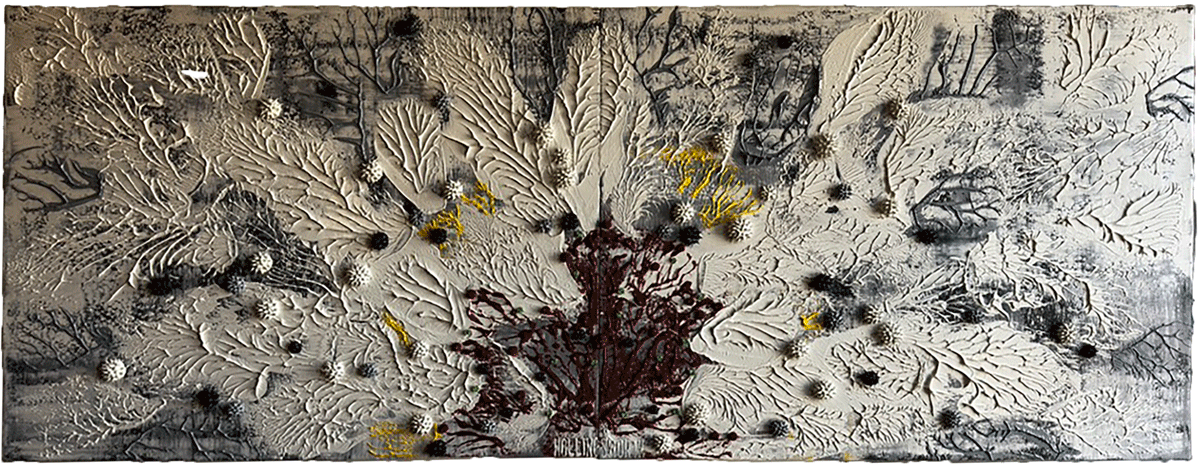
just so
2023
#634
36" x 96" or 48" x 72"*
Oil and Acrylic on Canvas over Wood Panel
* NOTA BENE
I have a strong "rule" not to rotate a canvas while I am painting it. In my entire oeuvre, I've embraced constraints as an implicit critique against a prevailing over swollen legacy of regarding art as a world of boundless possibilities. While it seems innocent enough, a healthy encouragement to attempt the impossible, to break out of boxes... in our Information Age, such an attitude has slipped into the back of our collective mind and has grown like weeds, forcing us into our current Zombified Hall of Mirror condition. Instead of spinning the canvas, hoping like a gambler for a lucky strike, I look for the happy accidents in other places. Irony rules our world: the boundless tends to wither possibilities, the boundaries can open the door to the boundless. In particular, I look what is possible within the surface tension of impasto paint and the gravity of its mass while all the while, my compass heading is fixed. Up is up and down is down. However...
This particular conjunctive pair of panels were indeed painted under the wide spread horizontally constrained format. But when I set the painting up to photograph and rack it in my studio, I flashed on the possibility to conjoin them in another configuration. My rule *evidently* [insert the winky emoticon here] applies only while I am engaged in the act of painting. It was an elegant rotation about an axis in the middle of my stamped signature, the left panel swinging down and over 270 degrees, while the whole assembly rotated port 90 degrees with the left becoming the right and the right becoming the left. ( I sense a twinge of a connection to the politics of our current geo-political period. Let's let this gun remain on the table for now. Silos must remain separate to remain silos... despite the occasional leak here and there.) Providence aligned all significant features of the painting while keeping its spirit intact. Post-hoc rotation is A-OKAY.
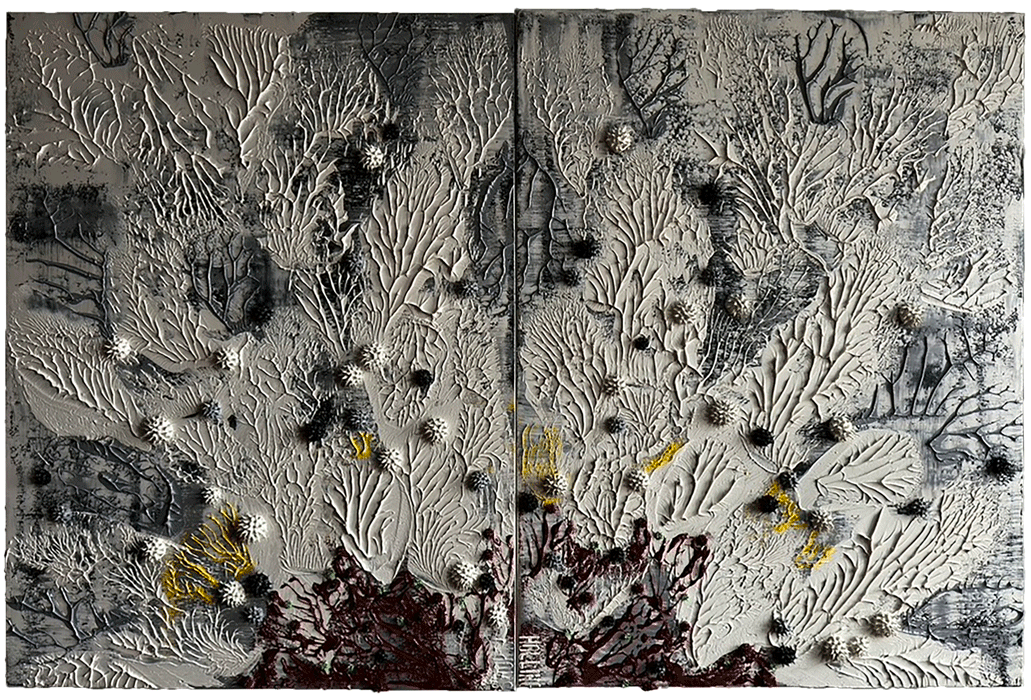
All this in a flash
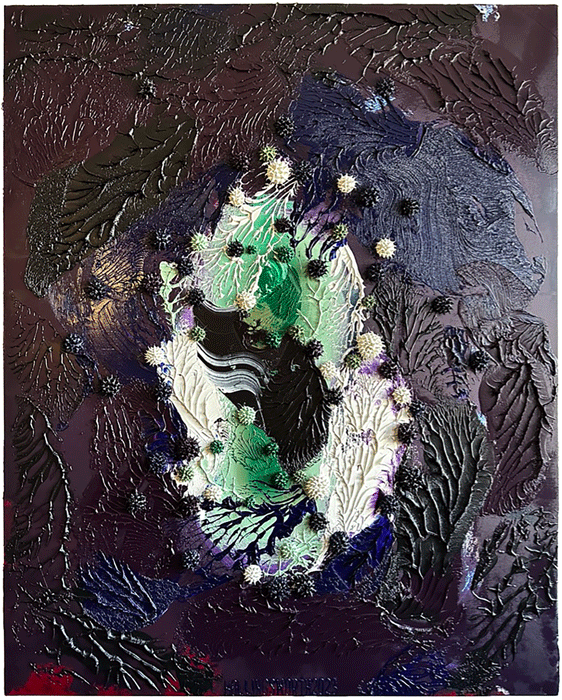
All this in a flash
2023
#633
60" x 48"
Oil and Acrylic on Canvas over Wood Panel
Wonders of the World
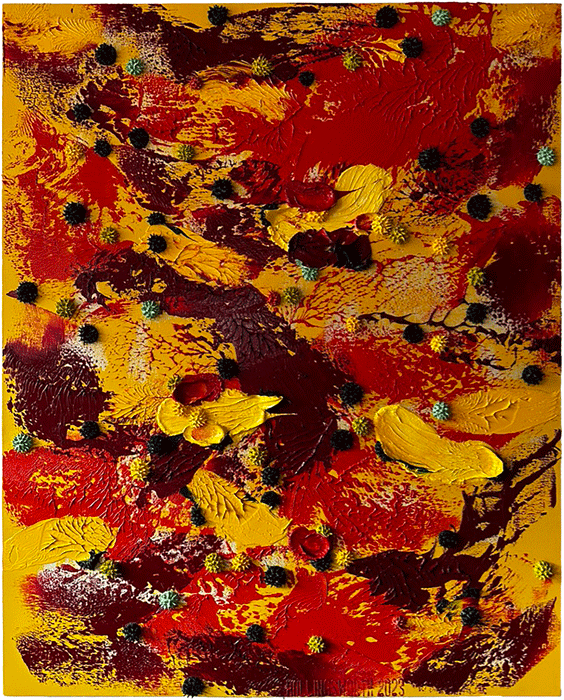
Wonders of the World
2023
#632
60" x 48"
Oil and Acrylic on Canvas over Wood Panel
Caché of the dare
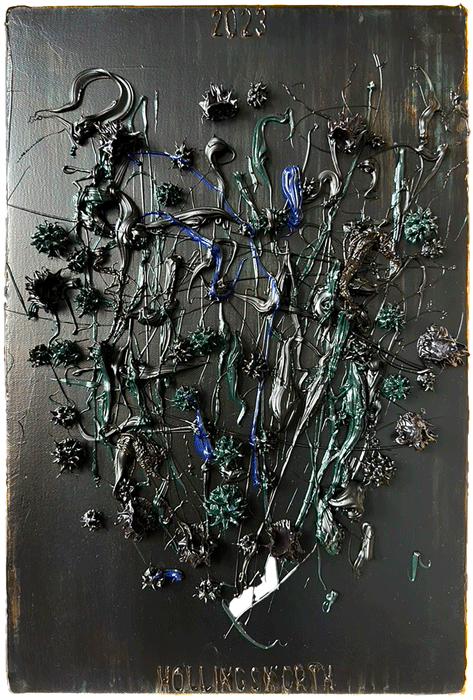
Caché of the dare
2023
#631
18" x 12"
Oil and Acrylic on Canvas over Wood Panel
Even within the fragment
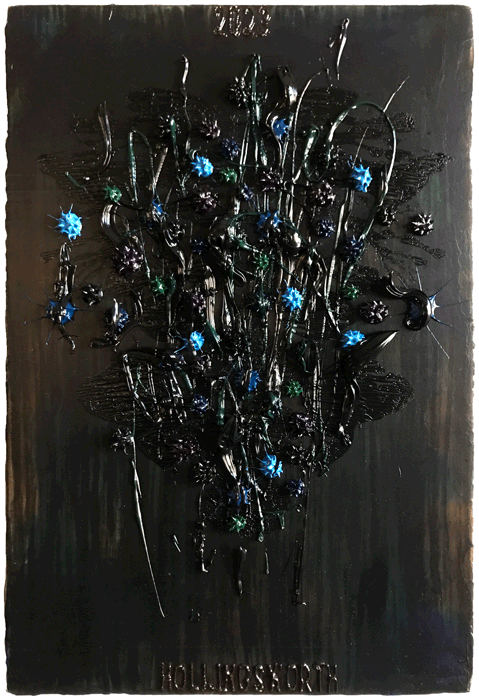
Even within the fragment
2023
#630
18" x 12"
Oil and Acrylic on Canvas over Wood Panel
Divulgement. Submission.
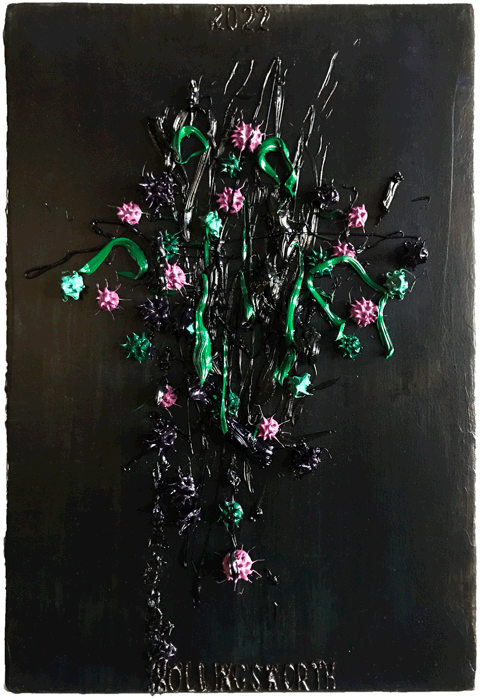
Divulgement. Submission.
2022 (2023)
#629
18" x 12"
Oil and Acrylic on Canvas over Wood Panel


















